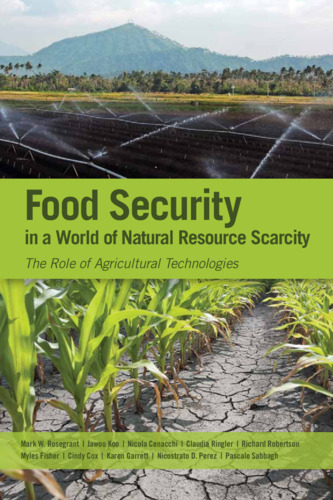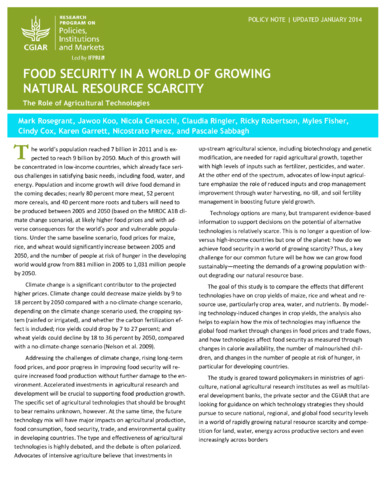Food security in a world of natural resource scarcity: The role of agricultural technologies
The International Food Policy Research Institute (IFPRI) business as usual projections of agricultural supply and demand anticipate a rise in food prices of most cereals and meats, reversing long-established downward trends. Between 2005 and 2050, food prices for maize, rice, and wheat are projected to increase by 104, 79, and 88 percent, respectively, while those for beef, pork, and poultry will rise by 32, 70, and 77 percent, respectively. Moreover, the number of people at risk of hunger in the developing world will grow from 881 million in 2005 to more than a billion people by 2050 (IFPRI International Model for Policy Analysis of Agricultural Commodities and Trade [IMPACT] baseline, Model for Interdisciplinary Research on Climate [MIROC] A1B scenario1 used in this book). More recent modeling efforts that use nine agricultural models, including both general equilibrium and partial equilibrium models, project that food price increases out to 2050 will be more moderate under climate change, with the IMPACT results in the medium range of price increases. Our results indicate increases in the real price of maize of 40–45 percent in 2050 and in the price of wheat and rice of 20–25 percent under climate change relative to a no–climate change scenario, using the Intergovernmental Panel on Climate Change (IPCC) Fifth Assessment with Representative Concentration Pathway (RCP) 8.5 and Shared Socioeconomic Pathway (SSP) 2 scenario2 (Nelson et al. 2013).
This book includes the following synopsis:
Rosegrant, Mark W.; Koo, Jawoo; Cenacchi, Nicola; Ringler, Claudia; Robertson, Richard D.; Fisher, Myles; Cox, Cindy M.; Garrett, Karen; Perez, Nicostrato D.; and Sabbagh, Pascale. 2014. Synopsis of Food security in a world of natural resource scarcity: The role of agricultural technologies. Washington, D.C.: International Food Policy Research Institute (IFPRI). https://ebrary.ifpri.org/digital/collection/p15738coll2/id/128023
Feeding the world in the decades leading up to 2050—decades that will see an increase in food demand spurred by population and income growth and stronger impacts of climate change on agriculture—will require increased and more sustainable agricultural production. To determine how to achieve such production, the authors of the study Food Security in a World of Natural Resource Scarcity used a groundbreaking modeling approach to assess the yield and food security impacts of a broad range of agricultural technologies under varying assumptions regarding climate change and technology adoption. Their approach combines process-based crop modeling of agricultural technologies with sophisticated global food demand, supply, and trade modeling. The authors’ focus was on the world’s three key staple crops: maize, rice, and wheat.
Authors
Rosegrant, Mark W.; Koo, Jawoo; Cenacchi, Nicola; Ringler, Claudia; Robertson, Richard D.; Fisher, Myles; Cox, Cindy M.; Garrett, Karen; Perez, Nicostrato D.; Sabbagh, Pascale
Citation
Rosegrant, Mark W.; Koo, Jawoo; Cenacchi, Nicola; Ringler, Claudia; Robertson, Richard D.; Fisher, Myles; Cox, Cindy M.; Garrett, Karen; Perez, Nicostrato D.; and Sabbagh, Pascale. 2014. Food security in a world of natural resource scarcity: The role of agricultural technologies. Washington, DC: International Food Policy Research Institute (IFPRI). https://doi.org/10.2499/9780896298477.
Keywords
Africa; Asia; Europe; South America; Northern America; Agricultural Policies; Agricultural Technology; Crop Yield; Mathematical Models; Zero Tillage; Soil Fertility; Precision Agriculture; Organic Agriculture; Nitrogen; Water Harvesting; Trickle Irrigation; Water Management; Crop Improvement; Drought Tolerance; Heat Tolerance; Plant Protection; Alternative Agriculture; Commodities; Trade; Food Supply; Food Security; Climate Change; Technological Changes; Commodity Markets; Resource Management; Economic Development; Nutrition; Malnutrition
Access/Licence
Open Access
Project
Policies, Institutions, and Markets







